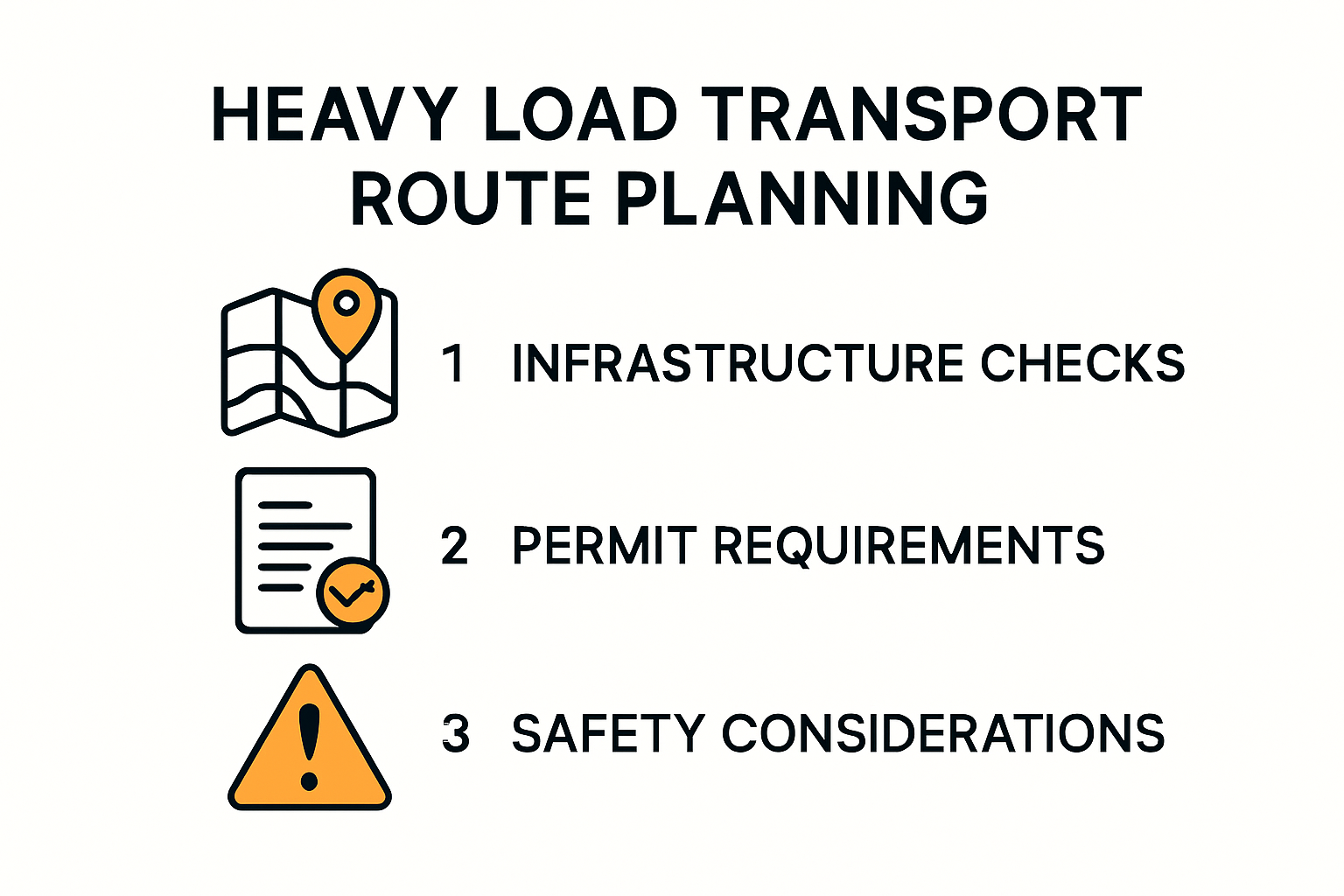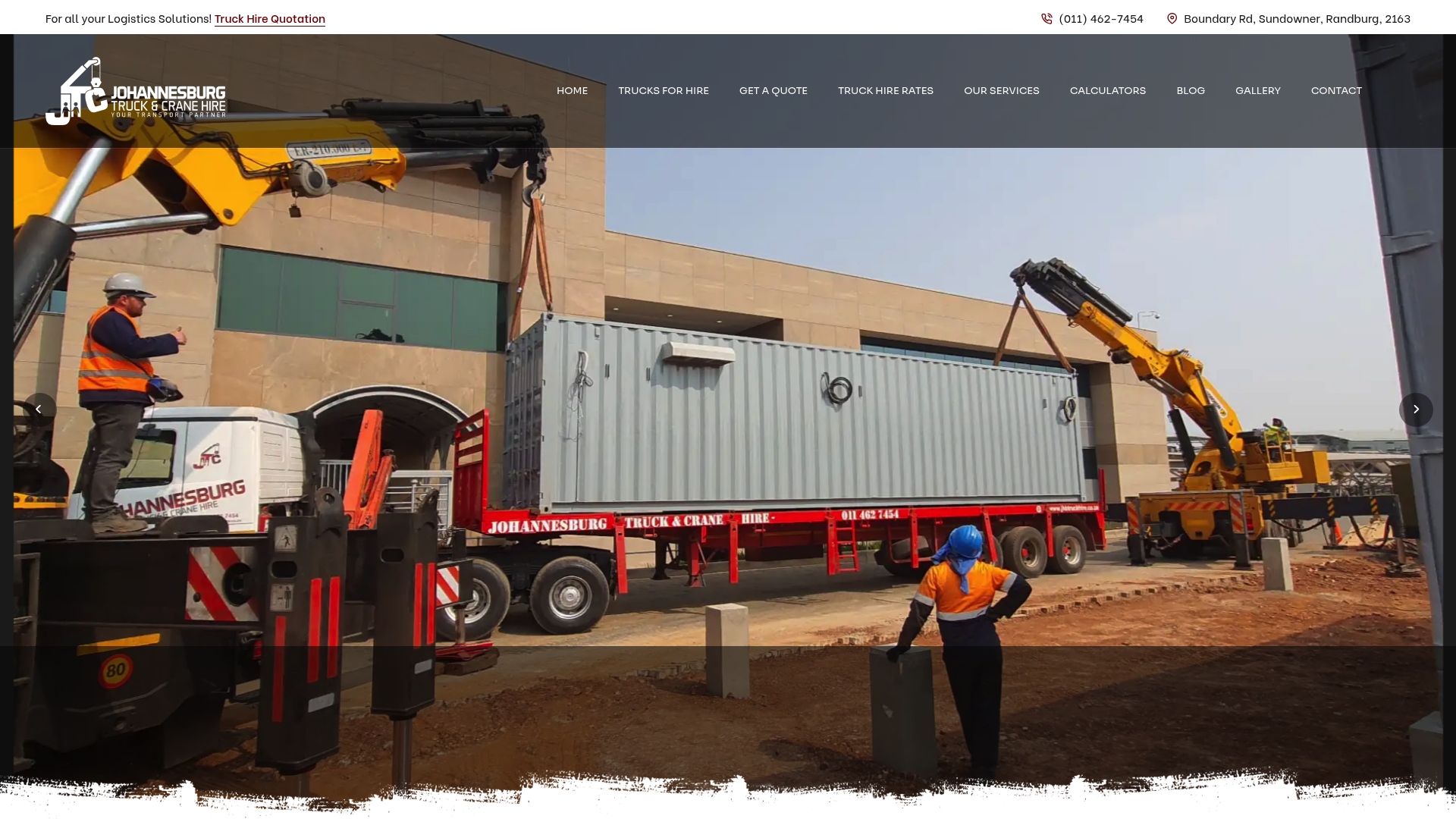
Heavy load transport is getting bigger and more complex every year, with routes and safety expectations in constant motion. Here is something few realize. A single mistake in load securement can lead to fines over $10,000 or total cargo loss. Some people think moving heavy freight is just about big trucks and strong straps, but there is way more science and strategy involved than you might expect.
Planning Heavy Load Transport Routes
Understanding Route Assessment Fundamentals
Regulatory Compliance And Permit Requirements
Advanced Route Optimization Strategies
Essential Safety Measures For Every Industry
Comprehensive Load Securement Standards
Regulatory Compliance And Operational Protocols
Advanced Risk Mitigation Technologies
Choosing The Right Equipment For Heavy Loads
Vehicle And Trailer Configuration Assessment
Specialized Equipment For Unique Transportation Challenges
Advanced Equipment Selection Technologies
Compliance And Permit Guidance For 2025
Regulatory Landscape Transformation
Permit Acquisition And Management Strategies
| Takeaway | Explanation |
|---|---|
| Thorough Route Planning is Essential | Strategic route assessment must consider infrastructure compatibility, regulatory compliance, and safety measures to ensure optimal heavy load transport. |
| Adhere to Load Securement Standards | Implementing rigorous load securement techniques is crucial to prevent cargo shifts, adhering to guidelines like SANS 10187 for enhanced safety. |
| Choose Equipment Based on Detailed Assessment | Equipment selection should be based on a comprehensive evaluation of cargo characteristics and vehicle capabilities to ensure operational efficiency. |
| Stay Updated on Regulatory Changes | Maintaining awareness of evolving regulatory frameworks and permit requirements is vital for compliance and operational legitimacy in heavy load transport. |
| Integrate Advanced Technologies for Risk Management | Leveraging modern technologies like telematics and predictive modeling can reduce operational risks and enhance overall transportation reliability. |

Transporting heavy loads requires meticulous route planning to ensure safety, efficiency, and compliance with transportation regulations. Strategic route selection impacts not just transportation costs but also potential risks and operational success.
Route planning for heavy load transport is a complex process that demands comprehensive evaluation of multiple critical factors. The strategic route planning guide highlights key considerations that transportation professionals must analyze before initiating any heavy load movement.
Infrastructure Compatibility represents the first crucial assessment. Not all roads are engineered to handle substantial weight. Transportation teams must carefully examine:
Bridge Weight Limits: Verify maximum load capacities for all bridges along the proposed route
Road Surface Quality: Assess pavement strength and potential structural weaknesses
Overhead Clearance: Confirm sufficient height clearance for oversized equipment
According to the National Transport Master Plan 2050, strategic infrastructure planning is essential for supporting economic development and improving transportation networks. Professional route planners utilize advanced mapping technologies and geographical information systems to conduct detailed route evaluations.

Navigating legal frameworks represents another critical aspect of heavy load transport route planning. The National Land Transport Act, 2009 mandates specific protocols for transporting abnormal loads across transportation networks.
Key regulatory considerations include:
Permit Acquisition: Securing necessary transportation permits for oversized or overweight loads
Route Restrictions: Understanding time-based and seasonal transportation limitations
Escort Vehicle Requirements: Determining when additional support vehicles are mandatory
Professional transportation teams must meticulously document and verify all regulatory requirements before commencing heavy load movements. This approach minimizes potential legal complications and ensures smooth transportation operations.
Modern heavy load transport demands sophisticated planning techniques that go beyond traditional route mapping. Advanced strategies incorporate real-time data, predictive analytics, and comprehensive risk assessment models.
Transportation professionals now leverage:
GPS Tracking Systems: Monitor vehicle location and route progress continuously
Weather Prediction Tools: Anticipate potential environmental challenges
Traffic Management Platforms: Identify and avoid congestion points
By integrating these technological solutions, transportation teams can develop robust route plans that maximize efficiency while minimizing potential disruptions. The goal remains creating a comprehensive strategy that balances safety, speed, and cost-effectiveness.
Effective heavy load transport route planning is not just about moving cargo from point A to point B. It represents a complex orchestration of technical expertise, regulatory knowledge, and strategic foresight. Professionals who master these intricate planning processes can transform potential logistical challenges into seamless transportation experiences.
Safety in heavy load transport transcends individual industries, representing a critical operational imperative that demands comprehensive strategic approaches. Protecting personnel, equipment, and cargo requires a holistic framework of integrated safety protocols and proactive risk management strategies.
Load securement represents the foundational cornerstone of transportation safety across multiple industries. The equipment safety guide emphasizes the critical importance of implementing rigorous securement techniques that prevent potential cargo shifts during transportation.
According to the South African Bureau of Standards (SABS), organizations must adhere to SANS 10187 standards, which provide comprehensive guidelines for load securement. Key requirements include:
Weight Distribution: Ensuring balanced and uniform cargo placement
Restraint Mechanisms: Utilizing appropriate strapping, chains, and tie-downs
Structural Integrity: Regularly inspecting securing equipment for wear and damage
Professional transportation teams must conduct meticulous pre-transport assessments, examining cargo configuration, potential movement risks, and appropriate restraint methodologies.
Navigating legal frameworks constitutes another crucial aspect of safety management. The National Road Traffic Amendment Act 64 of 2008 establishes comprehensive regulations governing vehicle registration, driver qualifications, and transportation safety standards.
Critical compliance considerations include:
Driver Certification: Mandatory training and skill verification
Vehicle Fitness: Regular mechanical inspections and maintenance
Dangerous Goods Transportation: Specialized handling protocols
The Road Transport Management System (RTMS) provides an additional voluntary regulatory framework that encourages transport operators to implement advanced management systems focused on infrastructure preservation and safety enhancement.
Modern safety strategies leverage sophisticated technological solutions to minimize potential transportation risks. Emerging technologies enable real-time monitoring, predictive analysis, and proactive intervention mechanisms.
Industry-leading safety technologies include:
Telematics Systems: Continuous vehicle performance tracking
Sensor-based Monitoring: Detecting potential load instability
Predictive Maintenance Platforms: Identifying equipment vulnerabilities before critical failures
By integrating these advanced technological approaches, transportation professionals can develop comprehensive safety ecosystems that significantly reduce operational risks and enhance overall transportation reliability.

Effective safety measures in heavy load transport demand a multifaceted approach that combines technical expertise, regulatory compliance, and technological innovation. Organizations that prioritize systematic safety protocols can transform potential risks into manageable, predictable operational processes, ensuring the protection of personnel, equipment, and cargo across diverse industrial landscapes.
Selecting appropriate equipment for heavy load transport represents a critical decision that directly impacts operational efficiency, safety, and overall transportation success. The complexity of equipment selection extends far beyond simple weight considerations, requiring a comprehensive understanding of technical specifications, operational requirements, and industry-specific challenges.
Choosing the right transportation equipment demands precise matching between cargo characteristics and vehicle capabilities. Our mobile crane load assessment guide provides crucial insights into matching equipment specifications with transportation needs.
According to research presented at the Southern African Transport Conference, developing Load Equivalency Factors (LEFs) helps transportation professionals make informed equipment selection decisions. Critical evaluation parameters include:
Gross Vehicle Mass: Determining maximum permissible weight
Axle Load Capabilities: Understanding distribution requirements
Suspension Specifications: Assessing shock absorption and stability
Professional transportation teams must conduct thorough equipment compatibility assessments, considering both static and dynamic load performance characteristics.
Different industries present unique heavy load transportation requirements that demand specialized equipment solutions. The South African Qualifications Authority (SAQA) emphasizes the importance of understanding equipment-specific securing mechanisms and load distribution techniques.
Key specialized equipment considerations include:
Flatbed Trucks: Ideal for oversized or irregularly shaped cargo
Lowbed Trailers: Designed for exceptionally heavy industrial machinery
Crane-equipped Vehicles: Enabling on-site loading and unloading capabilities
Transportation professionals must evaluate equipment based on cargo dimensions, weight, transportation distance, and specific industry requirements. Each equipment selection represents a strategic decision balancing performance, safety, and economic efficiency.
Modern equipment selection processes leverage sophisticated technological tools that provide unprecedented insights into transportation capabilities. Emerging technologies enable precise matching of vehicle specifications with cargo requirements.
Cutting-edge selection technologies include:
Digital Load Calculators: Providing instant equipment compatibility assessments
Predictive Modeling Platforms: Simulating transportation scenarios
Real-time Performance Monitoring Systems: Tracking equipment performance metrics
The Sustainability Initiative of South Africa (SIZA) highlights the critical importance of ongoing equipment assessment and maintenance to ensure consistent safety and reliability.
Effective equipment selection for heavy load transport transcends simple mechanical matching. It represents a complex interplay of technical expertise, technological innovation, and strategic foresight. Organizations that develop comprehensive equipment selection methodologies can transform potential logistical challenges into seamless, efficient transportation experiences across diverse industrial landscapes.
Navigating the complex landscape of heavy load transport compliance requires a comprehensive understanding of evolving regulatory frameworks and permit requirements. The transportation industry faces increasingly sophisticated regulatory environments that demand proactive approach and meticulous documentation management.
The 2025 transport compliance guide highlights significant regulatory shifts impacting heavy load transportation. The Economic Regulation of Transport Act of 2024 establishes a groundbreaking single transport economic regulator designed to enhance system efficiency and network accessibility.
Key regulatory developments include:
Comprehensive Permit Frameworks: More detailed documentation requirements
Digital Compliance Platforms: Enhanced electronic permit processing
Integrated Transport Network Regulations: Streamlined cross-sector transportation protocols
Transportation professionals must stay informed about these emerging regulatory mechanisms to maintain operational compliance and minimize potential legal complications.
The Administrative Adjudication of Road Traffic Offences (AARTO) introduces a sophisticated demerit point system that significantly impacts permit management and driver accountability. Critical considerations for permit acquisition include:
Professional Driving Permit Requirements: Rigorous verification processes
Vehicle License Compliance: Comprehensive documentation standards
Penalty Mitigation Strategies: Understanding potential point deduction mechanisms
Organizations must develop robust internal compliance management systems that proactively track and manage regulatory requirements, ensuring continuous operational legitimacy.
The Freight Road to Rail Migration Plan (FRRMP) represents a transformative approach to transportation management, encouraging alternative freight methodologies and introducing new compliance considerations.
Advanced compliance planning strategies encompass:
Predictive Compliance Modeling: Anticipating regulatory changes
Technology-enabled Tracking: Real-time regulatory compliance monitoring
Cross-industry Collaboration: Sharing best practices and regulatory insights
Successful transportation organizations recognize compliance as a dynamic, strategic process requiring continuous adaptation and proactive management. By developing comprehensive compliance frameworks that integrate technological solutions and regulatory expertise, companies can transform potential regulatory challenges into competitive advantages.
The future of heavy load transport compliance demands a holistic approach that balances technological innovation, regulatory understanding, and strategic foresight. Professionals who master these complex interactions will lead the industry toward more efficient, safe, and legally robust transportation ecosystems.
To help readers better compare equipment options described, here’s a summary table of specialized equipment and their key industrial uses:
| Equipment Type | Key Features / Use Case |
|---|---|
| Flatbed Trucks | Oversized/irregular cargo; open platform |
| Lowbed Trailers | Exceptionally heavy machinery; low deck height |
| Crane-equipped Vehicles | On-site loading/unloading; lifting capabilities |
Additionally, here is a process table outlining the essential steps and checks for regulatory compliance and permit management:
| Step | Description |
|---|---|
| Identify Permit Needs | Determine if load is oversized/overweight |
| Acquire Relevant Permits | Secure transportation permits per load/route requirements |
| Confirm Driver Certification | Ensure drivers have required training and licenses |
| Verify Vehicle Fitness | Conduct mechanical inspections and ensure roadworthiness |
| Maintain Documentation | Gather and manage all regulatory and permit paperwork |
| Monitor Regulatory Updates | Stay informed about evolving compliance requirements |
Ensuring heavy loads are securely fastened is crucial. Follow guidelines such as SANS 10187, which include weight distribution, proper restraint mechanisms like straps and chains, and regular inspections of securing equipment to prevent cargo shifts.
Optimizing routes involves assessing infrastructure compatibility, understanding regulatory compliance, and using advanced technologies like GPS tracking and traffic management systems to avoid congestion and hazards.
The equipment you need varies based on the load type. Options include flatbed trucks for oversized cargo, lowbed trailers for heavy industrial machinery, and crane-equipped vehicles for on-site loading and unloading capabilities.
Stay compliant by understanding current regulations, acquiring necessary permits, ensuring vehicles meet fitness standards, and keeping up with updates in the regulatory landscape. Implement a robust documentation management system to track compliance requirements.
If securing oversized freight, managing permits, or choosing the right crane for your move keeps you up at night, you are not alone. Sudden fines, route challenges, and the risk of a cargo disaster are real fears that heavy load transport professionals face. That is why every tip in this guide matters – and why partnering with proven experts can make the difference between stress and confidence.

Stop risking costly delays or compliance issues on your next move. Our team at JHB Truck Hire tackles everything the article covered, from detailed permit and escort planning for abnormal load transport to real on-site assessments and tailored rigging. Let our expertise in machine moving, mobile crane hire, and lift planning help you avoid the headaches. Ready for your safest, most hassle-free transport experience yet? Visit JHB Truck Hire today and let us handle the heavy load for you.
20 Ton Flatbed With Crane Truck For Hire
Efficient Truck Hire in South Africa: 10 Must-Know Tips